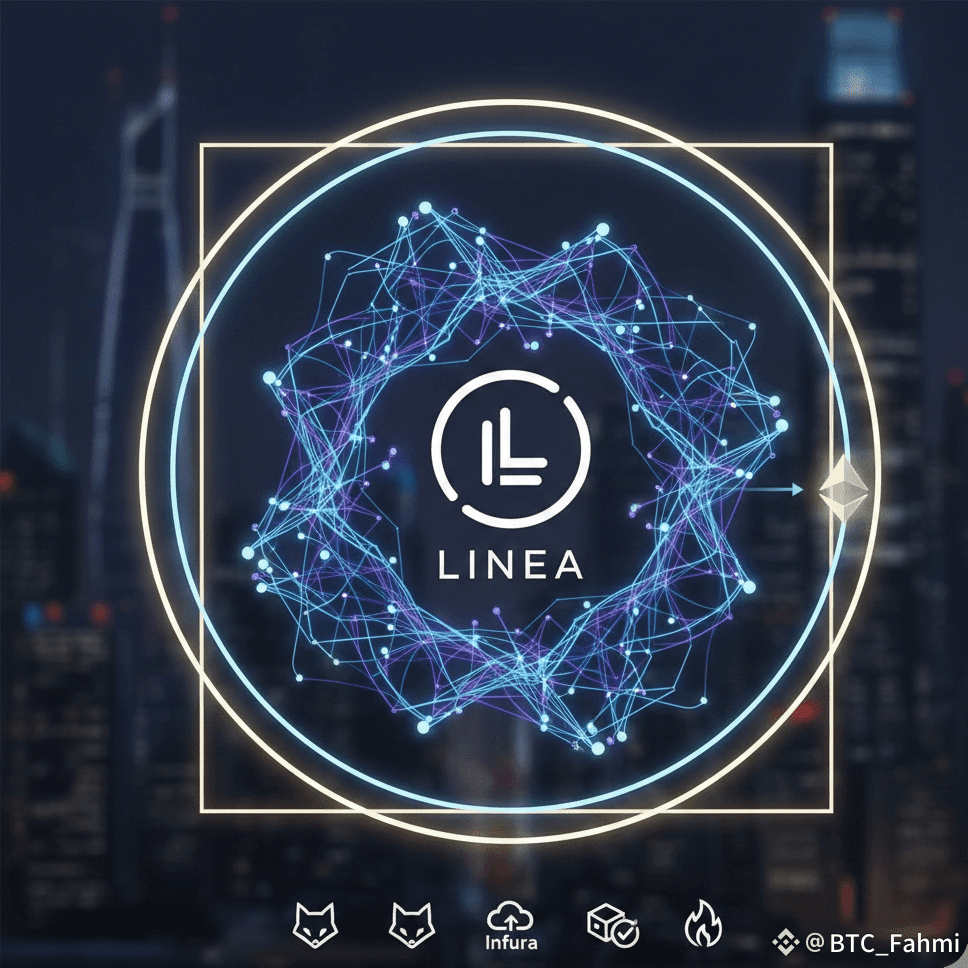
Linea is a Layer-2 network that helps Ethereum handle more activity without changing. How people already build on it. It’s created by ConsenSys the team behind MetaMask and Infura and it uses. Zero-knowledge proofs to make transactions faster and cheaper. The goal is simple fix Ethereum’s congestion and high fees in a way that feels almost invisible to users and friendly to developers. If you’ve ever used Ethereum during busy times. You’ve seen the problem Linea is trying to solve. The network gets crowded transactions slow down and gas fees jump to a few dollars or more even for small actions. Ethereum’s long-term upgrades will help but they won’t be enough on their own to handle the kind of global. Everyday usage people imagine. Linea’s approach is to move most of the heavy work off the main Ethereum chain. It processes transactions in its own environment. Then sends a compact cryptographic proof back to Ethereum showing that everything was done correctly. Ethereum stays in charge of security and final settlement. While Linea becomes the high-speed lane where most of the activity happens. One way to picture this is to think of Ethereum as a busy courthouse. Normally, every case has to be handled there from start to finish. Linea instead collects many cases works through them elsewhere and then returns to the courthouse with a solid math-based summary proving all cases were handled properly. The court only checks the proof instead of redoing the work. This is what the zkEVM does. It lets smart contracts written for Ethereum run inside Linea with no changes. A sequencer orders transactions into batches a prover creates the cryptographic proof that those batches are valid and a relayer manages communication between Linea and Ethereum. The end result is quick execution low fees and the same security and finality you get on Ethereum.
Linea also has its own token, called LINEA, but it’s used in a more modest way than many new tokens. You don’t pay gas with LINEA; gas fees are still paid in ETH. Instead, LINEA is used as a tool to grow and coordinate the ecosystem over time. It funds builders, supports new apps, backs public goods, and rewards early contributors. There’s no governance voting directly tied to the token. Decisions are currently made by the Linea Consortium, a group of Ethereum-aligned organizations that look after the network at this early stage. A key part of the token design is the burn mechanism. When people pay gas in ETH on Linea, part of the network’s net revenue is used to buy LINEA on the market and burn it, and a portion of ETH is burned as well. That means using Linea reduces the supply of both ETH and LINEA, linking Linea’s success closely to Ethereum’s. Linea’s place in the blockchain world is strengthened by its deep compatibility and connections. Because it is EVM equivalent any dApp built for Ethereum can be deployed on Linea with almost no changes. Its ties to MetaMask Infura and other ConsenSys tools give it a strong base wallets plug in easily RPC endpoints are ready and developers can use the same tools they already know. This makes Linea feel less like a rival to Ethereum and more like a natural extension of it a side road that widens the highway instead of building a new one. The ecosystem around Linea is already active. DeFi apps such as lending platforms and decentralized exchanges run on it. NFT creators and tools use Linea for cheaper minting and more experimentation. Payments products, including card services linked to MetaMask rely on Linea’s faster layer behind the scenes. There are also social apps no-code tools and cross-chain projects starting to appear. Linea’s “Voyage” onboarding campaign brought in millions of wallets giving new projects an immediate user base. Many new apps now choose to launch on Linea first and then expand to other networks later because the developer experience is so straightforward. However, Linea still faces real challenges. Right now important parts of the network like sequencers and provers are still run in a centralized way. The team has a plan to decentralize these with a multi-prover system, and that step will be crucial. It will decide whether Linea can become a fully trust-minimized network that stands on its own, rather than depending too heavily on ConsenSys. Economic sustainability is another open question. A large ecosystem fund can attract activity, but if it is not used wisely, it may draw in short-term farmers who leave once rewards dry up, instead of committed builders. On top of that, the Layer-2 space is very competitive. Optimism, Arbitrum, Polygon’s zkEVM, zkSync, and others are chasing similar goals. Over time, the market will probably narrow down to a handful of leading networks, and Linea will need to keep improving technically and economically to stay among them. Despite these uncertainties Linea’s long-term direction is fairly clear. It aims to be a “home network” where developers can build without friction users enjoy lower fees and higher throughput and Ethereum itself benefits from extra activity and burn effects. As Linea decentralizes and its role as an execution layer matures, it could become a major hub within the broader Ethereum ecosystem. Its strategy is to align tightly with Ethereum’s values support Ethereum rather than compete with it and gradually evolve into a self sustaining, proof-driven environment where the complex math of zero-knowledge cryptography is hidden behind smooth simple user experiences. What makes Linea appealing is its calm infrastructure-first attitude. It doesn’t try to impress with hype or big promises about “reinventing” blockchains. Instead. It offers something more subtle but very important a path for Ethereum to scale in a clean careful way without losing the strengths that made it the core of Web3 in the first place.



